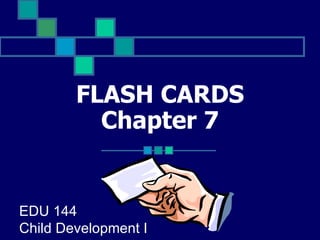
Edu 144 ch 7 flashcards
- 1. FLASH CARDS Chapter 7 EDU 144 Child Development I
- 2. According to Ainsworth, “an affectional tie” that an infant forms with a caregiver—a tie that binds them together in space and endures over time. Click for Term
- 4. A person’s realization that he or she is a distinct individual, whose body, mind, and actions are separate from those of other people. Click for Term
- 6. An infant’s expression of concern—a quiet stare, clinging to a familiar person, or sadness—when a stranger appears. Click for Term
- 8. An infant’s distress when a familiar caregiver leaves, most obvious between 9 and 14 months. Click for Term
- 10. Erikson’s first psychosocial crisis, infants learn basic trust if the world is a secure place where their basic needs (for food, comfort, attention, and so on) are met. Click for Term
- 12. A smile evoked by a human face, normally evident in infants about 6 weeks after birth. Click for Term
- 14. Erikson’s second crisis of psychosocial development. Toddlers either succeed or fail in gaining a sense of self-rule over their own actions and bodies. Click for Term
- 16. Learning that is accomplished by observing others. Click for Term
- 18. Inborn differences between one person and another in emotions, activity, and self-regulation. It is epigenetic, originating in genes but affected by child-rearing practices. Click for Term
- 20. A similarity of temperament and values that produces a smooth interaction between an individual and his or her social context, including family, school, and community. Click for Term
- 22. A theory that underlies the values and practices of a culture but is not usually apparent to the people within the culture. Click for Term
- 24. Caregiving practices that involve being physically close to a baby, with frequent holding and touching. Click for Term
- 26. Caregiving practices that involve remaining distant from a baby, providing toys, food, and face-to-face communication with minimal holding and touching. Click for Term
- 28. A coordinated, rapid, and smooth exchange of responses between a caregiver and an infant. Click for Term
- 30. An experimental practice in which an adult keeps his or her face unmoving and expressionless in face-to-face interaction with an infant. Click for Term
- 32. A relationship in which an infant obtains both comfort and confidence from the presence of his or her caregiver. Click for Term
- 34. Seeking information about how to react to an unfamiliar or ambiguous object or event by observing someone else’s expressions and reactions. Click for Term
- 36. Child care that occurs in a place especially designed for the purpose, where several paid adults care for many children. Usually, the children are grouped by age, usually licensed, with trained providers. Click for Term
- 38. A type of attachment that is marked by an infant’s inconsistent reactions to the caregiver’s departure and return. Click for Term
- 40. A laboratory procedure for measuring attachment by evoking infants’ reactions to stress. Click for Term
- 42. Child care that occurs in the home of someone to whom the child is not related and who usually cares for several children of various ages. Click for Term
- 44. A pattern of attachment in which an infant avoids connection with a caregiver as when the infant seems not to care about the caregiver’s presence, departure, or return or to both resist and seek contact on reunion. Click for Term
